When filling out the South Dakota Marital Separation Agreement form, many people make mistakes that can lead to confusion or delays. One common error is not providing complete information. Each section of the form requires specific details, and leaving anything blank can cause issues down the line.
Another mistake is failing to clearly define the terms of separation. Ambiguous language can lead to misunderstandings between spouses. It’s essential to be as clear and specific as possible about the agreements made regarding property, finances, and custody arrangements.
Some individuals overlook the importance of including all assets and debts. It’s easy to forget about certain accounts or loans, but omitting these can create problems later. Both parties should take time to list everything accurately to avoid disputes.
People often forget to consider tax implications. Decisions made during separation can affect future tax filings. Consulting with a tax professional before finalizing the agreement can help ensure that both parties understand the financial consequences of their choices.
Another frequent mistake is not having the agreement reviewed by a legal professional. While it might seem straightforward, having an attorney look over the document can catch potential issues that one might miss. This step can save time and trouble in the future.
Some individuals rush through the signing process. It’s crucial to ensure that both parties fully understand the agreement before signing. Taking the time to discuss and clarify any concerns can prevent future disagreements.
Lastly, people sometimes fail to keep copies of the signed agreement. After everything is finalized, it’s important to have a record for both parties. Keeping a copy ensures that everyone has access to the same information moving forward.
